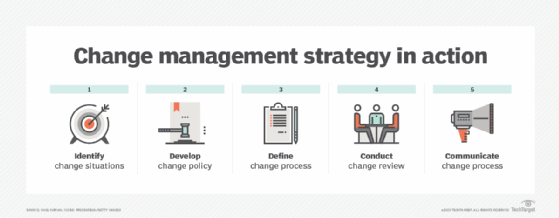change management strategy
What is a change management strategy?
A change management strategy is a plan for or systematic approach to dealing with a transition or transformation in an organization. In business, a change management strategy describes specific ways in which a company addresses change in goals, processes or technology related to parts of the business, such as the supply chain, inventory requirements, scheduling and sales management.
The goal of establishing an effective change management strategy is to minimize negative effects of change and to keep project scope in check. To institute a change management strategy, key stakeholders must create a plan for how to do the following:
- Recognize when a change is needed.
- Approve changes.
- Implement changes.
- Monitor changes to ensure they delivered the desired effect.
How does a change management strategy work?
A change management strategy provides a framework and guidance on how changes are identified, evaluated, approved and implemented. Elements of a strategy include an overall change management process, change management plans, and a communication plan for advising stakeholders and management on the status of change management initiatives. Good project management is essential because each change request can be considered its own project.
Organizational change and digital transformation are two business processes requiring change management. These types of initiatives involve a series of smaller changes that depend on a change management strategy to finish on time and stays within budgetary requirements:
- Identify needs. Identify and assess situations where changes are likely to occur. This can be for any business process, and especially within information technology (IT). It's wise to formulate a change management policy that outlines the strategy and defines processes associated with it.
- Define policies. Formulate and get consensus on any policies that are needed to undertake these changes.
- Develop a process. Describe in detail the process needed to make the change happen, starting at a high level and breaking it down into specific applications. This can include the use of specialized technology to support change management activities.
- Create a change review panel. The role of this group is to review change requests and approve or reject them based on input from the change initiators and other sources as well as data and metrics relevant to the change.
- Communicate. The strategy should include processes for communicating decisions regarding change requests and keeping senior management informed of change activities' statuses.

Who uses change management?
Transformational change comes to all organizations at some point. And change management in one form or another is required when it does.
All employees should be aware of and understand the change management strategy. The change management team can use data from the change efforts to identify opportunities for resource planning, supply chain management, operations management, new product development and other areas.
Incremental vs. radical changes
Change management models typically address a variety of requests. Many are incremental changes or incremental innovation aimed at fine-tuning an overall process or modifying an established activity to make it more effective.
Less common are radical changes that involve major alterations in an established activity, such as replacing a corporate financial system or swapping out an old phone system for one using new technology. A flexible change management strategy is needed to adapt to the nuances of a specific type of change no matter how simply or profoundly it might affect the organization.
Benefits of a change management strategy
Done properly, change management helps control costs, manage productivity, identify opportunities for improvement, support innovation, streamline decision-making and even improve morale. Employees find it motivating when they see their change requests get implemented.
In IT, successful change management supports better documentation and digital transformation initiatives. It can result in better systems and software. From a cybersecurity perspective, change management processes ensure that systems protecting network perimeters have the most current rules and controls.
Challenges of a change management strategy
When developing a change management methodology, management team members must factor in the existing company culture. The way things have been done for years can become an obstacle to smooth change processes. However, applying processes that have employee and management buy-in reduces resistance to change.

Taking a holistic approach to organizational change management is also important because change can affect just about every aspect of an organization, including human resources, operations, risk, financial operations, assets and resources.
Other challenges include creating timely and effective communications, accounting for the potential complexities of proposed changes in technology and business processes and overcoming resistance from employees who are attached to the status quo and feel threatened by or have differing views about specific changes.
Change management strategy is a key part of digital transformation. Find out what you need to know about those processes in our guide to digital transformation.







